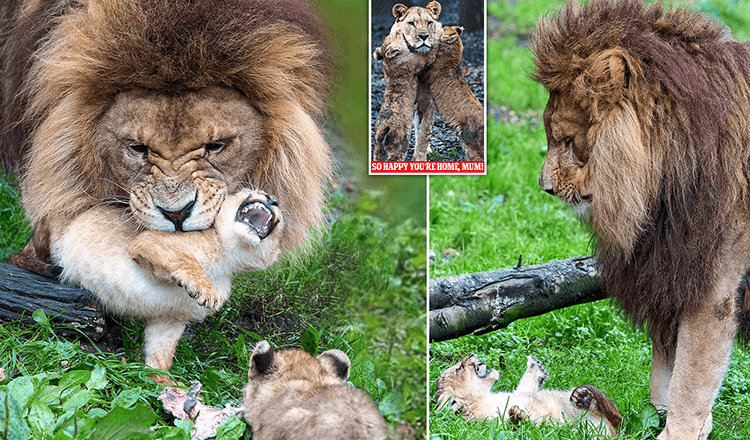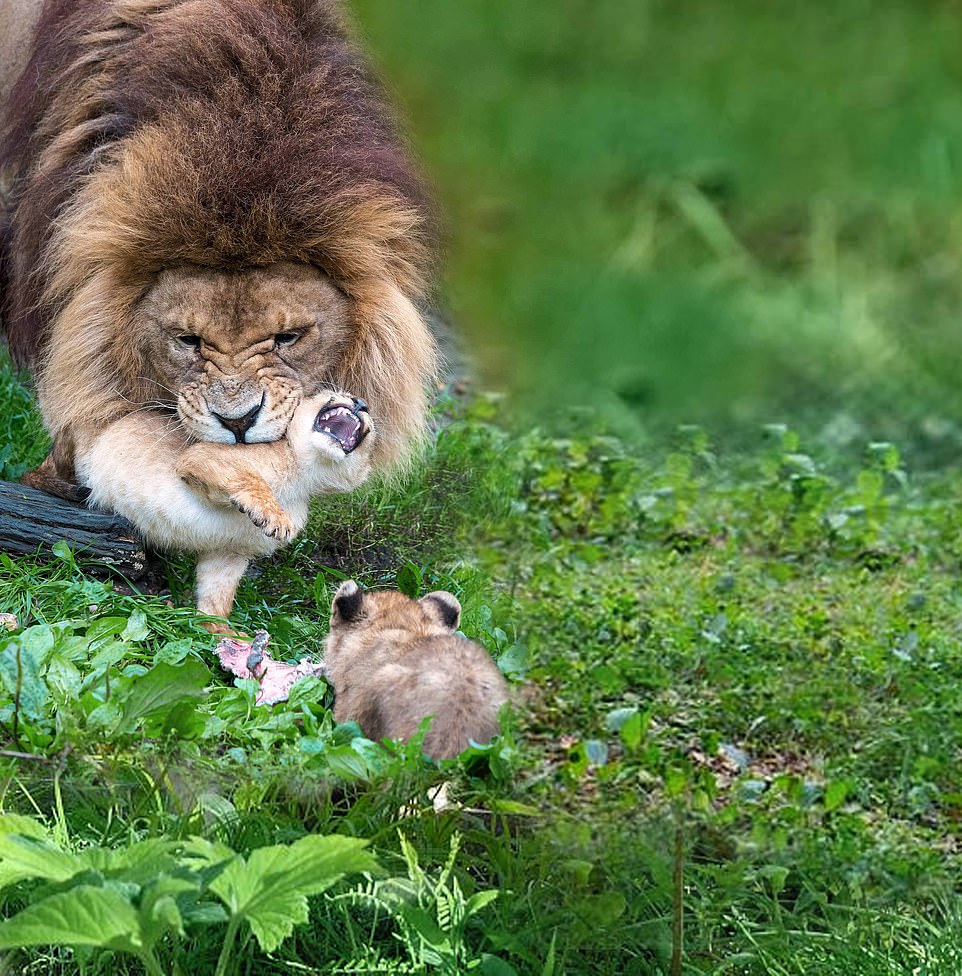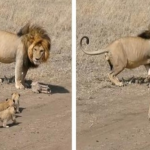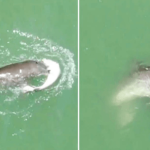
It’s not simply people who’re combating the burden of sudden further childcare in the meanwhile, as these exceptional pictures present.
Father lion struggles to handle 5 unruly cubs whereas their mom recovers from being attacked by one other lioness
Singa, an African lion, discovered his pack of 5 u.nruly cubs have been greater than a handful – or ought to that be pawful? – when mum was away.

Though he gave the impression to be attempting his finest, his parenting expertise weren’t fairly as much as the duty of caring for his younger brood at Pakawi Park Zoo in Belgium whereas their mom, JJ, underwent medical therapy.

Singa, an African lion dwelling in Pakawi Park Zoo in Belgium, s.truggled to take care of his 5 cubs whereas mum was within the hospital recovering from an i.njury brought on by one other lioness

Singa tried to carry the cubs to hold them to a safer place the way in which their mom would however didn’t know do it correctly making them cry each time he got here close to them

Dad was light with the cubs and really tolerant of their t.antrums however bought a bit g.rumpy once they began to chunk his tail
Wildlife photographer Linda Smit defined: ‘The mom was a.ttacked by one other lioness. She had extreme i.njuries and needed to be separated from her cubs for a number of weeks to h.eal. So dad needed to handle them.
‘He was attempting to carry them, just like the mom would do, to hold them to what he in all probability thought was a safer place. However as a male, he didn’t have the talents or expertise to correctly carry them.
‘Though he was very light with the cubs, they screamed each time he got here close to and tried to maneuver them. He was very tolerant with them, however he did get a bit g.rumpy once they have been biting his tail.’
The cubs have been clearly delighted when JJ was restored to well being by zoo vets and returned to their enclosure, as the ultimate image exhibits.
When mum returned from the vets, absolutely recovered from her damage, the cubs have been completely delighted to have their favorite mother or father again

When mum returned from the vets, absolutely recovered from her damage, the cubs have been completely delighted to have their favourite mother or father again
What 5 traits do all animals have in widespread?
What 5 traits do all animals have in widespread?
Within the following slides, we’ll discover the fundamental traits shared by all (or at the least most) animals, from snails and zebras to mongooses and sea anemones: multicellularity, eukaryotic cell construction, specialised tissues, sexual replica, a blastula stage of growth, motility, heterotrophy and possession …
What traits do all animals have in widespread quizlet?
The six traits that every one organisms within the animal kingdom share are: they’re multicellular, virtually all can transfer, their cells haven’t any cell wall, they should hunt for their very own meals (customers), they’re eukaryotic, reproduce sexually-when two cells be part of to kind off spring and their cells lack chloroplasts.
What 4 traits do all animals share?
Most animals share these traits: sensory organs, motion, and inside digestion. All of them are illustrated in Determine under. Animals can detect environmental stimuli, resembling mild, sound, and contact. Stimuli are detected by sensory nerve cells.
What are the 7 traits of all animals?
- 1 Vitamin. Dwelling issues absorb supplies from their environment that they use for development or to offer vitality.
- 2 Respiration.
- 3 Motion.
- 4 Excretion.
- 5 Progress.
- 6 Replica.
- 7 Sensitivity.
What are the 6 traits widespread to all animals?
They’re as follows:
- All animals are made up of cells that wouldn’t have cell partitions.
- All animals are multicellular organisms.
- Most animals reproduce sexually.
- All animals are able to self-propelled movement in some unspecified time in the future of their lives.
- All animals are heterotrophic and should eat different organisms for vitality.
What protein do all animals have in widespread?
The exctracellular protein collagen (making essentially the most considerable extracellular protein in animals) which is required in multicellular organisms to maintain the cells collectively, which is unique to animals. Most enzymes answerable for metabolic pathways.
What are the three traits of animals?
Traits of Animals
- Animals are multicellular organisms.
- Animals are eukaryotic.
- Animals are heterotrophic.
- Animals are typically motile.
- Animals possess specialised sensory organs resembling eyes, ears, nostril, pores and skin, and tongue.
- Animals reproduce sexually.
What are the fundamental traits of all animals?
Within the following slides, we’ll discover the fundamental traits shared by all (or at the least most) animals, from snails and zebras to mongooses and sea anemones: multicellularity, eukaryotic cell construction, specialised tissues, sexual replica, a blastula stage of growth, motility, heterotrophy and possession of a complicated nervous system.
What do all animals have in widespread with one another?
Sexual replica is one other attribute shared by most, however not all, animals. No matter species, all animals share multicellularity, which suggests their our bodies encompass a number of cells. This units animals other than organisms, resembling single-celled algae, fungi, micro organism and different primary life types.
What do vegetation and animals have in widespread?
Most vegetation are additionally multicellular, so though this can be a attribute shared by all animals, it isn’t one distinctive to animals.Each animal on the planet is a eukaryote. A eukaryote is an organism that consists of cells which have membrane-bound nuclei and organelles.
What are the traits of the animal kingdom?
All animals are eukaryotic, multicellular organisms, and most animals have complicated tissue construction with differentiated and specialised tissue. Animals are heterotrophs; they have to eat residing or useless organisms since they can not synthesize their very own meals and might be carnivores, herbivores, omnivores, or parasites.



